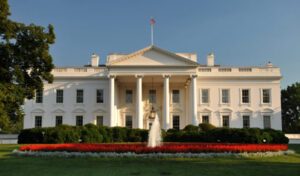 Today, at the White House Summit on Advanced Air Mobility, stakeholders expressed concerns over security, the possibility of uncrewed technology being used by bad actors for terrorism or warfare, and the critical need for the reauthorization and expansion of the Preventing Emerging Threats Act of 2018 set to expire October 5, 2022
Today, at the White House Summit on Advanced Air Mobility, stakeholders expressed concerns over security, the possibility of uncrewed technology being used by bad actors for terrorism or warfare, and the critical need for the reauthorization and expansion of the Preventing Emerging Threats Act of 2018 set to expire October 5, 2022
Continue reading below, or listen:
Major General Sean Gainey, Director of Counter Unmanned Aircraft Systems of the US Army, gave a keynote discussion emphasizing the use of commercially available drones by bad actors in crime and in current geopolitical conflicts around the world.
“I’ve been in this business of air threats for a long time,” said Gainey. “…We are always focused on the threat and the evolving threat… Whatever technology we put out there, there is always an evolving threat.”
Gainey’s presentation was troubling, outlining the risks that bad actors pose with easily accessible technology that can be modified relatively simply. In addition to surveillance and identification of targets, criminals can use uncrewed technology to jam or scramble the systems of authorized manned aircraft, deliver contraband, carry explosives, and more.
“You can create havoc with what is intended as a good technology,” said Gainey. “I’m very surprised it hasn’t been taken even further – it’s a very difficult problem set.”
The good news is that solutions exist to help ensure drone and Advanced Air Mobility security: sophisticated counter UAS (cUAS) systems that can detect, identify and mitigate threats from uncrewed systems. But, as Summit panelists point out, very few agencies are granted the authorization to use them.
The U.S. has strict laws governing wire tapping technologies, “jamming” technologies, and the interference with aircraft. Those laws protect drones also: and prohibit the use of most available cUAS solutions in many situations. The Preventing Emerging Threats Act of 2018 granted very limited authority to the Department of Justice. Stakeholders say the authority is not sufficient to adequately protect the majority of public events, sporting events, critical infrastructure installations, or even airports from drones operated with criminal intent – whether that’s to take unauthorized footage of the Super Bowl, or do something worse.
“My job is to protect large gatherings,” said Cathy Lanier, Chief Security Officer of the National Football League. “…That means securing the space above and the space below… we have a 360 degree range of responsibility.” Lanier supports the expansion of legal authority to deploy counter drone technology, pointing out that areas under discussion are already under a Temporary Flight Restriction (TFR). “That legal authority already exists,” says Lanier, suggesting that lawmakers use the existing model of authority found in counterterrorism legislation.
As the October expiration date for the Preventing Emerging Threats Act of 2018 nears, the Department of Justice says that it’s time to renew and expand the Act, granting authority to more stakeholders in order to protect the public.
“There are major gaps in the authority,” said Lucien Sikorskyj, Principal Deputy Assistant Secretary for Counterterrorism, Threat Prevention, and Law Enforcement (Acting), Department of Homeland Security. He points out, for example, that the Transportation Security Administration (TSA) is not authorized to detect or request mitigation for rogue drones in the airspace around public airports; and that critical infrastructure owners cannot always legally implement cUAS at their properties.
While agencies may be able to request that Department of Justice step in to oversee protection from drone threats, “The demand is far outstripping our resources,” said Brad Weigman, Deputy Assistant Attorney General, Office of Law and Policy, National Security Division, Department of Justice.
Weigman says that the Department of Justice proposes that state, local, and tribal law enforcement as well as critical infrastructure owners be granted detection capabilities, using federally approved equipment and under government training and supervision programs.
“The threat landscape is continually increasing and evolving,” Weigman said.
Read more about the Preventing Emerging Threats Act of 2018:
- S.2836, Preventing Emerging Threats Act: Can Homeland Security Take Down Small Drones?
- DOJ Reports Multiple Drone Violations During Public Events
Read more about eVTOL and Advanced Air Mobility:
- Advanced Air Mobility in Southern California: Wisk Aero Partners with Long Beach
- North Carolina Grants AeroX $5 Million for Advanced Air Mobility Development
- Publicly Traded Advanced Air Mobility Companies: Lilium, Archer Join Joby, Ehang
- OneSky Joins NASA on Advanced Air Mobility National Campaign
- Public Acceptance: the Linchpin for Advanced Air Mobility and Passenger Drones

Miriam McNabb is the Editor-in-Chief of DRONELIFE and CEO of JobForDrones, a professional drone services marketplace, and a fascinated observer of the emerging drone industry and the regulatory environment for drones. Miriam has penned over 3,000 articles focused on the commercial drone space and is an international speaker and recognized figure in the industry. Miriam has a degree from the University of Chicago and over 20 years of experience in high tech sales and marketing for new technologies.
For drone industry consulting or writing, Email Miriam.
TWITTER:@spaldingbarker
Subscribe to DroneLife here.







[…] Robotics Co-Founder and CEO Reese Mozer, who was not too long ago invited to participate within the White Home Summit on Superior Air Mobility. “I’m happy with the years of dedication and onerous work that our crew, companions, and […]